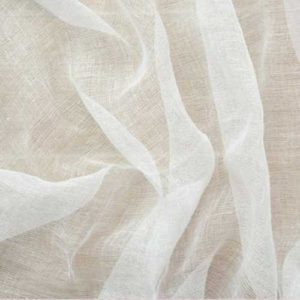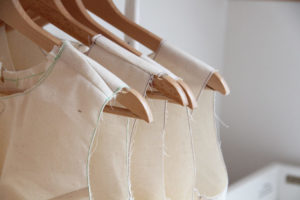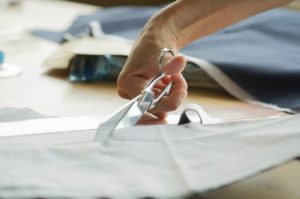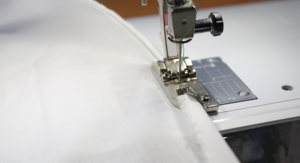What Is Muslin? | How To Sew Muslin?
Jump To:
Muslin, commonly referred to as “double gauze,” light, fluid, and transparent, it can be woven in different materials: cotton, silk, wool, viscose. Perfect for little summer dresses, the muslin will lend itself perfectly to making tops, blouses, or even accessories, decoration. Muslin, composed of very fine threads, is fragile due to its loose weave and must therefore be handled with great care.

What is muslin fabric used for?
Perfect for small baby blankets or summer clothes, muslin is available in both solid colors and patterns. It can be single, double, or even triple. When it is double or triple, we are talking about several layers of gauze fused, making it a little thicker and creating tiny alveoli thanks to the fusion of the fabrics. Different types of muslin fabrics for different uses.
Types Of Muslin Fabrics
Classic chiffon
Made from 100% cotton muslin for comforting breathability, softness to the touch, and ultimate versatility.
Soft silky chiffon
Combines the breathability and versatility of muslin with bamboo rayon for unrivaled softness.
Organic muslin
Made from 100%, GOTS certified organic cotton grown in an environmentally and socially responsible manner.
Stretch muslin
made from natural cotton muslin with a hint of spandex for comforting breathability and the right amount of stretch.
How To Sew Muslin

Step 1: Washing
Before sewing any fabric, it must be washed beforehand. Start by performing the mop test to verify that your fabric will not discolor. To do this, place a damp cloth on your fabric and apply the iron for a few seconds. If the color has rubbed off on the fabric, hand washes it in cold water with a mixture of vinegar and coarse salt to set the color.
For other washes, prefer washing by hand, in a basin or a sink filled with hot water. Apply pressure from top to bottom on the garment in soapy water and then rinse it with lukewarm water. Above all, do not wring out the fabric, place it flat between two terry towels, then hang it up and let it air dry.
If, however, you wish to machine it, place it in an underwear bag and choose the delicate mode of your machine with a low spin.
How To Soften Muslin?
For more softness and hold: You can apply a primer, which will be sprayed on the fabric or added to its rinse water. This will consist of starch or gelatin.
- To make a starch-based primer: mix 20 grams of rice starch in a saucepan of cold water. Then add 1 liter of hot water while stirring the mixture. Bring the solution to a boil for a few seconds, then let it cool. Filter the mixture through a Chinese and add 500ml of white vinegar and a tablespoon of glycerin. Mix well and spray on the fabric.
Step 2: Ironing
In general, avoid ironing. To do this, dry your garment flat between two terry towels.
However, if ironing is essential, use a cloth while being careful not to crush the fabric with your iron. You can also place the garment on a hanger and bring the steam closer to the iron to loosen the folds gently.
Step 3: How To Cut Muslin Fabric

Fragile and very fine, muslin requires working on a smooth and very flat surface. Pin or even fix your fabric to your surface using masking tape. Choose extra fine pins to avoid snags.
Place tissue paper on the lining of your muslin and cut both simultaneously, this will prevent possible tears in the fabric. Your scissors must be fine and sharp to prevent fraying.
Necessary equipment
- The machine needle: it is best to use a fine micro textile type needle ( size 60 ) or a classic 70 needle.
- The thread: choose a fairly fine thread such as cotton or polyester n ° 40 for example.
Step 3: Stitching Muslin Fabric
We recommend a 2mm stitch.
To prevent the fabric from puckering between the stitches, sew a straight, tight stitch.
Do not hesitate to build your parts before assembly so that they do not slip or form unsightly folds.
Given its transparency, the seams should be fine, clean, and discreet. To do this, we recommend that you adopt one of the following two methods:
- The English seam: it is a doubled seam, easy to achieve, and rather aesthetic.
- Place your pieces of fabric on top of each other, on the wrong sides together, stitch the seam allowances 5mm from the seam line. Trim the excess about 3mm from the seam. Iron the seam allowances.
- Fold the fabric, this time with the right side inside, so that the first seam is placed in the fold of the fabric. Iron the fold and then topstitch on the seam line to completely enclose the allowances of the previous seam.
- The shirt seam: this is lighter than the English seam and consists of two parallel stitches on the right side of the garment.
- Stack two pieces together, wrong sides together and offset the front edge by 1 cm. Fold the cm of the back edge over the front edge and sew 5 mm very precisely from the folded edge. It is essential that this stitching is straight and perfectly parallel to the fold. Iron the seam.
- Open the two layers of fabric and place the right side towards you. Cast off the 5mm seam (folded edge) at the front, over the back edge. Stitch from the right side, flush with the folded seam.
Best Hem For Muslin – Rolled Hem

By machine:
Insert a hemmer foot. Fold the hem twice and sew a few stitches to hold the crease. With the needle down, slip the folded fabric into the hemmer foot. Lower the foot and start stitching by slightly tensioning the fabric and shifting it to the left.
By hand:
Method 1:
Machine stitch 6mm from the unfinished edge and reduce the tuck near the stitch. Roll about 3mm between thumb and forefinger, hiding the bite. Stabilize the roulette between the middle and ring fingers and sew in slip stitches, taking a single fabric thread. This method is easier to perform if the fabric is wrapped around a basting thread, if possible of a color approaching that of the fabric as the thread will remain in the hem.
Method 2:
Stitch and reduce as in Method 1. Fold the edge back about 3mm and mark the fold. Take a thread from the fold and stitch the needle at an angle into the unfinished edge, taking a thread from the edge. Work in a zigzag fashion, spacing the stitches 6mm apart. Repeat the process for 2 or 3 cm, then pull the thread to tighten the stitches, thus forming the roulette.
Chiffon hem:
-
- Fold the hem 1 cm from the wrong side and sew very small straight stitches flush with the fold of the fabric. Iron the stitching to flatten the seam. With scissors, cut the hem flush with the stitches. Slip the round blade of the scissors under the hem to reduce the risk of pinching the garment’s fabric.
- Fold the stitched edge back on itself and stitch it. Then iron.
Tips:
- Use a needle plate with one hole and a straight stitch presser foot. If you are using a zigzag stitch needle plate, which has a larger hole, the fabric may rush into the hole.
- NEVER reverse as the fabric may catch in the needle or the plate and pucker.
- So that the feed teeth of the machine do not damage your fabric, you can place tissue paper between your muslin and your machine; the fabric will be protected and will slide more efficiently during the stitching.
What is the difference between muslin and cotton?
What Is the Difference Between Cotton and Muslin? Muslin fabric is made from cotton, but certain forms can also incorporate silk and viscose. Muslin differs from other cotton weaves used for items like shirts and dresses because it has a much looser, more open weave.
What kind of cloth is muslin?
muslin, plain-woven cotton fabric made in various weights. The better qualities of muslin are fine and smooth in texture and are woven from evenly spun warps and wefts, or fillings. They are given a soft finish, bleached or piece-dyed, and are sometimes patterned in the loom or printed.
What is muslin used for?
Muslin is a versatile, multi-purpose cloth used in dressmaking, furniture polishing, theatre sets, and even medicine. It is a healthy, organic fabric and can be put to good use around the home without spreading chemical residue and, most importantly is reusable and stops the cycle of waste.
Is muslin cotton?
Muslin is lightweight and breathable (and, as we mentioned, soft as a mother’s touch), credit to its makeup: a light, loose, plain weave cotton material.
Is muslin the same as quilters cotton?
While similar in nature, cotton and muslin fabrics are often used for creating different things. In the quilting world, cotton is usually the go-to fabric, but muslin can be used as long as it’s durable and high-quality.
Is muslin good for face mask?
Cotton muslin is tightly woven to prevent droplets from getting out but doesn’t keep you from struggling to breathe. That makes it the best fabric for cloth face masks.
Is muslin and cheesecloth the same thing?
Muslin fabric is finer than cheesecloth and is the choice for creating garments to wear in very hot or humid climates. Since it is inexpensive, muslin fabric is also used to make a muslin, or a sewn draft, of an actual pattern. Muslin fabric is available in both natural unbleached colors and bleached white.
What does muslin fabric look like?
It’s usually beige or of another plain, undyed, unbleached color, although these days you can also find dyed muslins. Muslin has been around for centuries and is believed to have originated in present-day Iraq, where it was made in the city of Mosul (hence its name).
What is muslin used for baby?
as a comforter: many babies love the texture of muslin cloth, rubbing it against their faces as a soother. And you can save many tantrums by having a stack of spares for when one needs a wash, gets left behind, eaten by the dog, as an over-the-shoulder burnt cloth.
What is muslin cloth cooking?
Homemade jams and marmalades may seem like a faff, but as soon as you taste them, the effort is all worthwhile. Muslin cloths are used to strain the mixture and remove any lumps of seeds, leaving you with a smooth preserve worthy of any loaf or cake.
What is cheesecloth material?
Cheesecloth is a cotton cloth that is loosely woven and resembles gauze. It comes in seven grades, from open to extra-fine weave.
What is a muslin blanket?
Muslin is a finely woven, breathable fabric known to occur in the Middle Ages in Bangladesh. Due to the delicate yet durable weave, the material is stretchy and thus perfect for swaddling. The woven fabric enables the blanket to be tucked snugly around a baby without being too restrictive.
Is muslin a breathable fabric?
Muslin refers to a finely-woven breathable fabric, which makes it just the type of material you want to wrap your baby in. Muslin is lightweight and breathable (and, as we mentioned, soft as a mother’s touch), credit to its makeup: a light, loose, plain weave cotton material.
Can a baby breathe through a muslin?
Blankets made from fabrics like muslin that can be breathed through are a better option for little ones than thick, quilted blankets. Weighted blankets that are sometimes used for older children with sensory concerns are not safe for use with infants.
Is muslin a polyester?
This category of muslin is a medium-weight polyester. It is 128″ wide and sold by the running yard. Poly muslin material drapes more easily than cotton, making it ideal for backdrops, drapery, cycloramas, and more. Poly muslin is also not stiff like other cotton fabrics and can be easily used in humid climates.
